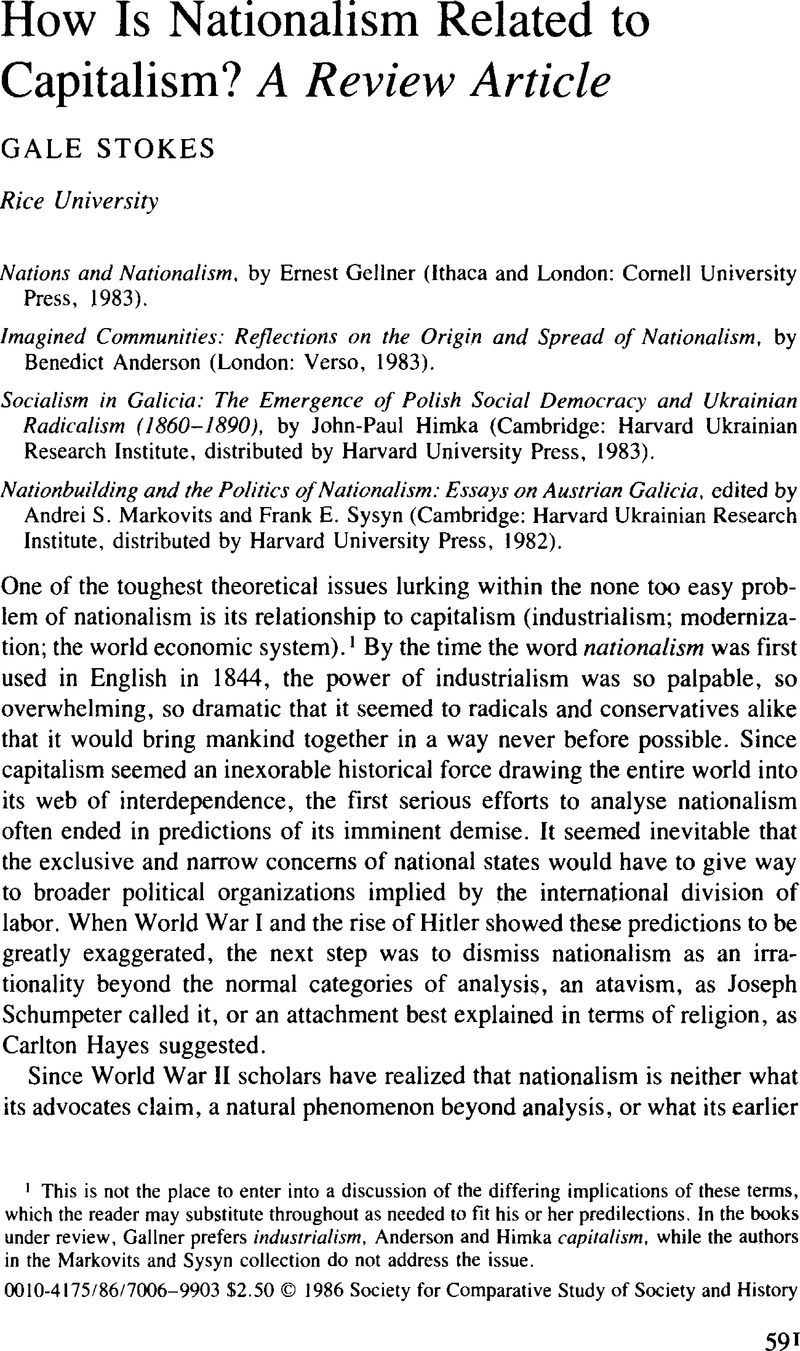Article contents
How Is Nationalism Related to Capitalism? A Review Article
Published online by Cambridge University Press: 03 June 2009
Abstract

- Type
- CSSH Discussion
- Information
- Copyright
- Copyright © Society for the Comparative Study of Society and History 1986
References
1 This is not the place to enter into a discussion of the differing implications of these terms, which the reader may substitute throughout as needed to fit his or her predilections. In the books under review, Gallner prefers industrialism, Anderson and Himka capitalism, while the authors in the Markovits and Sysyn collection do not address the issue.
2 The literature on nationalism can be followed in the annual bibliographies published by The Canadian Review of Studies in Nationalism (Charlottetown, Prince Edward Island)Google Scholar and the booklength bibliographies published by Garland Press under the general editorship of Thomas Spira, editor of the CRSN. For discussions of the state of the art in the 1970s, see Smith, Anthony D., “Nationalism: A Trend Report and Bibliography,” Current Sociology, 21:2 (1973), 1–185Google Scholar, which is superior to his Theories of Nationalism (New York: Harper and Row, 1972)Google Scholar in that regard; my review article, “The Undeveloped Theory of Nationalism,” World Politics, 31 (1978), 150–60CrossRefGoogle Scholar; and Eley, Geoff, “Nationalism and Social History,” Social History, 6 (1981), 83–107.CrossRefGoogle Scholar
3 Hopkins, Terence K. and Wallerstein, Immanuel, “Research Proposal: Patterns of Development of the Modern World-System,” Review, 1:2 (Fall 1977), 113Google Scholar. Historians often simply avoid this basic contradiction and concentrate on describing or categorizing, e.g., Seton-Watson, Hugh, Nations and States (Boulder, Colo.: Westview Press, 1977)Google Scholar; and Snyder, Louis, Global MiniNationalisms: Autonomy or Independence, Contributions in Political Science Series, no. 71. (Westwood, Conn., and London: Greenwood Press, 1982).Google Scholar
4 Europeans have pursued Deutschean initiatives more than have writers in English, e.g. Horch, Mirosla, Die Vorkämpfer der nationalen Bewegung bei den kleinen Völkern Europas (Prague: Charles University, 1968)Google Scholar; and Schieder, Teodor and Dann, Otto, eds., Nationale Bewegung und soziale Organisation I: Vergleichende Studien zur nationalen Vereinsbewegung des 19. Jahrhunderts in Europa (Munich: R. Oldenbourg Verlag, 1978).Google Scholar
5 For a recent discussion of these points, see Foltz, William J., “Modernization and NationBuilding: The Social Mobilization Model Reconsidered,” in From National Development to Global Community: Essays in Honor of Karl W. Deutsch, Merritt, Richard L. and Russett, Bruce M., eds. (London: George Allen and Unwin, 1981), 25–45Google Scholar. Deutsch recently republished many of his most seminal articles in book form. Tides among Nations (New York: The Free Press, 1979)Google Scholar. One of the early critiques of modernization theory still worth reading is Tipps, Dean C., “Modernization Theory and the Study of National Societies: A Critical Perspective,” Comparative Studies in Society and History, 15:2 (03 1973), 199–226.CrossRefGoogle Scholar
6 Smith, Anthony D., “The Diffusion of Nationalism: Some Historical and Sociological Perspectives,” British Journal of Sociology, 29 (1978), 242.CrossRefGoogle Scholar
7 Breuilly, John, Nationalism and the State (New York: St. Martin's Press, 1982)Google Scholar; Stokes, Gale, Balkan Nationalism: An Annotated Bibliography (New York: Garland Press, 1984)Google Scholar, intro. The entire area of ethnic studies also tends toward noneconomic explanations. For a richly textured study of ethnic symbolism over the longue durée, see Armstrong, John, Nations before Nationalism (Chapel Hill: University of North Carolina Press, 1982).Google Scholar
8 Tom Nairn, one of the few Marxists who have attacked the problem, goes so far as to declare that “the theory of nationalism represents Marxism's great historical failure” (“The Modern Janus,” New Left Review, 94 (11-12 1975), 3Google Scholar, quoted by Anderson, p. 13); and Eley, Geoff, writing in Social History, 6 (1981), 104, stresses “the need to re-situate the historiography of nationalism in a strong context of socio-economic analysis.”Google Scholar
9 Hopkins, and Wallerstein, , “Research Proposal: Patterns of Development,” 119–20, 127.Google Scholar
10 Gellner first laid out the ideas that have come to fruition in this book in his Thought and Change (Chicago: University of Chicago Press, 1963Google Scholar) and outlined them again in “Scale and Nation,” Philosophy of the Social Sciences (Aberdeen), 3:1 (03 1973), 1–17.CrossRefGoogle Scholar
11 Anderson is not accurate here (p. 42). A vernacular market of significant proportions existed from the beginning. See, e.g., Davis, Natalie Zemon, “Printing and the People,” in her Socìety and Culture in Early Modern France (Stanford: Stanford University Press, 1975), 189–226. This does not necessarily vitiate Anderson's over-all point, however, which is very broadly stated: “the convergence of capitalism and print technology on the fatal diversity of human language created the possibility of a new form of imagined community” (p. 49).Google Scholar
12 Cf. Gellner, , p. 127: “The media do not transmit an idea which happens to be fed into them. … It is the media … themselves … which … automatically engenders [sic] the core idea of nationalism, … that core message is that the language and style of the transmission is important, that only he who can understand them, or can acquire such comprehension, is included in a moral and economic community.”Google Scholar
13 For a striking discussion of a similar effect in Eastern Europe, see Verdery, Katherine, Transylvanian Villagers: Three Centuries of Political, Economic, and Ethnic Change (Berkeley, Los Angeles, and London: University of California Press, 1983). The Romanian peasants studied by Verdery never really developed a class consciousness under the pressures of economic exploitation, but tended to see nationality as the chief issue in politics.Google Scholar
14 See Dan, Otto, ed., Lesegesellschaften und bürgerliche Emanzipation, Ein europäischer Vergleich (Munich: Verlag C. H. Beck, 1981).Google Scholar
15 “While the German book market expanded into a truly national one after 1866, … the German political press remained, despite industrialization, restricted in size and distribution to local markets…. The over three thousand German papers of the seventies appeared in about 1500 almost hermetically sealed areas.” Keyserlingk, Robert H., Media Manipulation: The Press and Bismarck in Imperial Germany (Montreal: Renouf Publishing Company, 1977), 8–9.Google Scholar
- 4
- Cited by


